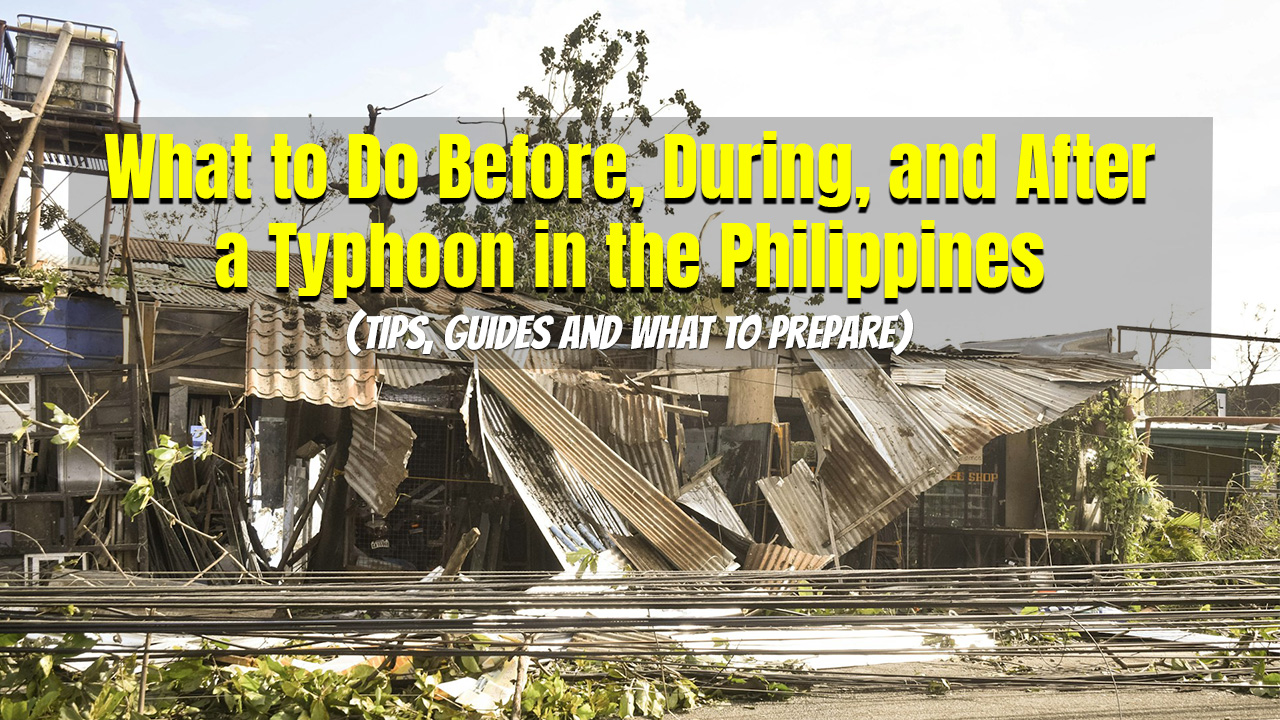
The Philippines, located in the Pacific Ring of Fire and along the typhoon belt, is one of the most disaster-prone countries in the world. Typhoons, locally known as “bagyo”, are a common occurrence, with an average of 20 typhoons entering the Philippine Area of Responsibility (PAR) each year. These powerful storms bring heavy rains, strong winds, and the potential for widespread flooding and destruction, impacting millions of lives and causing significant economic losses.
Preparing for a typhoon is essential to ensure the safety and well-being of individuals, families, and communities. The effects of typhoons can range from minor disruptions to devastating damage, but proactive measures can significantly reduce risks and improve recovery efforts. This guide provides actionable steps to take before, during, and after a typhoon, helping Filipinos minimize risks, protect lives, and recover effectively from the impacts of these natural disasters. Following these guidelines can make a significant difference in managing the challenges typhoons bring.
Whether you live in a flood-prone area, near the coastline, or in urban centers, understanding how to prepare, respond, and recover is crucial. By staying informed and taking necessary precautions, you can protect yourself, your loved ones, and your property from harm.
WHAT TO DO BEFORE A TYPHOON
Monitor Weather Updates
- Regularly check weather forecasts from reliable sources such as PAGASA (Philippine Atmospheric, Geophysical, and Astronomical Services Administration).
- Follow updates on local radio, television, or social media platforms to stay informed about typhoon warnings and advisories.
- Familiarize yourself with the different Public Storm Warning Signals (PSWS) and their corresponding impacts.
Prepare an Emergency Kit
Having a well-stocked emergency kit is crucial for surviving the aftermath of a typhoon. Your kit should include:
- Non-perishable food items: Canned goods, rice, biscuits, and other items that do not require refrigeration or cooking. These are essential when power outages make cooking impossible.
- Drinking water: At least one gallon per person per day for three days to ensure hydration in case water supplies are contaminated.
- Flashlights, candles, and extra batteries: For illumination during power outages.
- Portable radio: To receive updates even when internet or cell signals are down.
- First-aid supplies: Bandages, antiseptics, pain relievers, and any necessary medications to treat injuries or manage health conditions.
- Important documents: Birth certificates, insurance policies, IDs stored in waterproof containers to prevent loss or damage.
- Power banks and extra chargers: To keep phones and essential devices operational.
- Basic tools: A multi-purpose knife, duct tape, ropes, and tarpaulins for quick repairs.
- Extra clothing, blankets, and rain gear: To keep warm and dry in case of evacuation or exposure to the elements.
Secure Your Home
- Inspect your home for potential hazards and make necessary repairs, such as fixing leaky roofs or reinforcing windows.
- Trim trees and shrubs around your property to prevent falling branches from causing damage.
- Bring outdoor furniture, potted plants, and other loose items indoors to prevent them from being swept away by strong winds.
- Ensure that your drainage system is clear to reduce the risk of flooding.
Plan Evacuation Routes
- Identify the nearest evacuation centers in your area and familiarize yourself with the safest routes to reach them.
- Coordinate with local authorities and community leaders to understand evacuation protocols.
- Practice evacuation drills with your family to ensure everyone knows what to do in case of an emergency.
Coordinate with Family Members
- Establish a communication plan with your family to stay connected during the typhoon.
- Agree on a meeting point in case you get separated.
- Teach children how to call for help and what to do in emergencies.
ESSENTIAL ITEMS, THEIR USES, AND SCENARIOS
Non-Perishable Food and Water
- Use: Provides sustenance when cooking or purchasing food is not possible.
- Scenario: Prolonged power outages or limited access to grocery stores due to flooding.
Flashlights and Extra Batteries
- Use: Ensure visibility during nighttime when power is unavailable.
- Scenario: Navigating through a dark home or evacuation center.
First-Aid Kit
- Use: Treat minor injuries, prevent infections, and manage chronic health conditions.
- Scenario: Cuts from debris or emergencies where medical help is delayed.
Portable Radio
- Use: Stay informed about weather updates and official announcements.
- Scenario: Communication disruptions due to network outages.
Waterproof Container for Documents
- Use: Protect critical documents from water damage.
- Scenario: Flooded homes or evacuation to water-prone areas.
Basic Tools and Tarpaulins
- Use: Quick fixes to damaged roofs, windows, or structures.
- Scenario: Immediate repair to prevent further damage after strong winds.
Power Banks
- Use: Keep mobile phones and devices charged to maintain communication.
- Scenario: Prolonged blackouts or during evacuation.
Rain Gear and Protective Clothing
- Use: Stay dry and reduce the risk of hypothermia.
- Scenario: Walking through flooded areas or during evacuation under heavy rain.
Ropes and Multi-Purpose Knives
- Use: Useful for securing belongings or during rescue operations.
- Scenario: Securing tarps or helping in makeshift repairs.
WHAT TO DO DURING A TYPHOON
Stay Indoors
- Remain inside a secure area of your home or evacuation center throughout the typhoon.
- Avoid areas near windows and doors that could shatter due to strong winds or flying debris.
- Use heavy furniture to barricade doors and windows if necessary.
Monitor Weather Updates
- Keep a battery-powered radio or mobile device tuned to updates from PAGASA or your local government unit (LGU).
- Follow instructions from authorities, especially regarding evacuation orders and curfews.
Avoid Dangerous Areas
- Stay away from floodwaters, rivers, and coastal areas as they pose risks of drowning and contamination.
- Do not attempt to cross flooded streets or bridges, as strong currents can sweep you away.
- Avoid using appliances or touching electrical devices if your home is flooded to prevent electrocution.
Use Emergency Supplies Wisely
- Ration food and water to ensure they last throughout the duration of the storm.
- Use flashlights instead of candles to reduce the risk of fire, especially in enclosed spaces.
- Keep your emergency kit accessible at all times.
WHAT TO DO AFTER A TYPHOON
Ensure Safety First
- Wait for official announcements from local authorities or PAGASA before leaving your shelter.
- Check your surroundings for hazards such as live electrical wires, weakened structures, or debris.
- Avoid wading through floodwaters, which may be contaminated or contain hidden dangers like sharp objects.
Inspect Your Home
- Assess any damage to your property and document it with photos or videos for insurance claims.
- Report any downed power lines, gas leaks, or other hazards to the proper authorities immediately.
- Make temporary repairs to prevent further damage, such as covering holes in the roof with tarpaulins.
Clean Up Carefully
- Wear protective gear such as gloves, boots, and masks while cleaning to avoid injuries or exposure to harmful substances.
- Disinfect surfaces and items that have come into contact with floodwater to prevent the spread of diseases.
- Dispose of debris and spoiled food properly to maintain hygiene.
Seek Assistance if Needed
- Contact your local government or relief organizations for assistance with food, water, shelter, and medical care.
- Inform family and friends of your situation and seek their support if necessary.
- Reach out to community groups or NGOs for additional help in rebuilding and recovery efforts.
Stay Informed
- Continue monitoring news updates for additional warnings or announcements about relief efforts and rehabilitation programs.
- Participate in community meetings to stay updated on recovery plans and resources.
CONCLUSION
Typhoons are a part of life in the Philippines, but their impacts can be mitigated through proper preparation, vigilance, and timely action. By knowing what to do before, during, and after a typhoon, you can protect yourself, your loved ones, and your community from harm. Remember, the key to surviving and thriving despite natural disasters is resilience—a combination of preparedness, cooperation, and adaptability.
While typhoons are inevitable, the devastation they cause doesn’t have to be. Stay informed, stay prepared, and work together to build a safer and more resilient Philippines. Share this guide with others to spread awareness and ensure everyone is equipped to handle the challenges posed by typhoons.
Related Articles:
– 7 Colorful and Vibrant Philippine Festivals That Should Be on Your Bucket List
– Discover the Philippines: Top Must-Visit Destinations and Experiences
– Comprehensive Guide to Teachers Salary Grades in the Philippines (2024): Updates, Benefits, and Career Progression
– Everything You Need to Know about Pamamanhikan
– Philippines Public Holidays 2024

